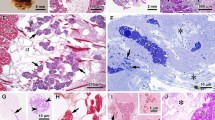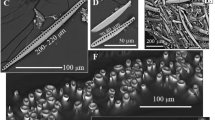Abstract
The actively-secreting cells of the calciferous glands ofLumbricus terrestris are roughly dome shaped. The basal part of the cell consists of numerous interdigitating cell processes. These processes contain numerous mitochondria and membranous infoldings, forming vesicles which migrate to various regions of the cell. The nucleus is irregular and centrally located. The supranuclear region is occupied to a great extent by the rough endoplasmic reticulum, several Golgi complexes and numerous granules derived from the Golgi complexes. These granules enlarge and are extruded into the gland sinus, where they eventually become reorganized and mineralized to give rise to spheroliths.
Radioautographs of glands removed 30 min following injection of45Ca showed uptake of the isotope located almost exclusively in the cells; 4–24 h later the isotope was located in the spheroliths in the gland cavity.
These cells apparently perform two functions necessary for the production of mineralized spheroliths, 1, absorption and transport of calcium from the basal region to the cell surface and 2, the elaboration of a protein matrix in which mineralization occurs.
Résumé
Les cellules activement sécrétantes des glandes riches en calcium deLumbricus terrestris ont une forme en dôme. La partie basale de la cellule présente de nombreux prolongements ramifiés. Ces prolongements contiennent de nombreuses mitochondries, ainsi que des invaginations de la membrane formant des vésicules qui migrent dans diverses parties de la cellule.
Le noyau irrégulier est en position centrale. La région supranucléaire contient surtout de l'ergastoplasme, plusieurs appareils de Golgi et de nombreuses granules provenant de l'appareil de Golgi. Ces granules augmentent de taille et sont rejetées dans le sinus de la glande, où elles se modifient et se calcifient pour donner des sphérolithes.
Des radioautographics glandulaires, obtenues 1/2 heure après injection de Ca45, montrent une localisation isotopique, située presque exclusivement dans les cellules; 4–24 heures après, l'isotope se localise dans les sphérolithes de la cavité glandulaire.
Ces cellules semblent assurer deux fonctions liées à la production de sphérolithes: 1. absorption et transport de calcium de la région basale vers la surface cellulaire et 2. formation d'une matrice protéique qui se calcifiera.
Zusammenfassung
Die aktivsezernierenden Zellen der calcifizierenden Drüsen vonLumbricus terrestris sind annähernd kuppelförmig gestaltet. Der untere Teil dieser Zellen besteht aus unzähligen ineinandergreifenden Zellfortsätzen. Diese Fortsätze enthalten zahlreiche Mitochondrien und membranöse Einstülpungen, welche Bläschen bilden, die zu den verschiedenen Regionen der Zelle wandern.
Der Zellkern ist unregelmäßig und zentral angeordnet. Die supranukleäre Region ist zu einem großen Teil mit grobem endoplasmatischem Reticulum und mehreren Golgi-Komplexen sowie zahlreichen Granula, die von den Golgi-Komplexen stammen, ausgefüllt. Diese Granula vergrößern sich und werden in den Drüseninus ausgestoßen, wo sie schließlich reorganisiert und mineralisiert werden, um Sphärolithen zu bilden.
1/2 Std nach Injektion von Ca45 wurde die Drüse entfernt; eine Radioautographie zeigte, daß das Isotop beinahe ausschließlich in den Zellen lokalisiert war; 4–24 Std später befand sich das Isotopin den Sphärolithen der Drüsenhöhlung.
Diese Zellen sind anscheinend an zwei für die Bildung von mineralisierten Sphärolithen notwendigen Funktionen beteiligt:
-
1.
an der Calcium-Absorption und deren Transport von der Basalregion bis zur Zelloberfläche;
-
2.
an der Bildung einer Proteinmatrix, in welcher die Mineralisation stattfindet.
Similar content being viewed by others
References
Arnott, H. J.: Studies of calcification in plants. In: Calcified tissues (1965) (ed. Fleish, H., H. J. J. Blackwood and M. Owen), p. 152–157. Berlin-Heidelberg-New York: Springer 1966.
Bevelander, G., Nakahara, H.: A histochemical and cytological study of the calciferous glands ofLumbricus terrestris. Physiol. Zool.32, 1, 40–46 (1959).
——: An electron microscope study of the formation of the nacreous layer in the shell of certain bivalve molluscs. J. Calc. Tiss. Res.3, 1, 84–92 (1969a).
Bevelander, G., Nakahara, H.: An electron microscope study of the formation of the ligament ofMytilus edulis andPinctada radiata. J. Calc. Tiss. Res. (in press) (1969 b).
Crang, R. E., Holsen, R.C., Hitt, J. B.: Calcite production in mitochondria of earthworm calciferous glands. Biol. Sci.18, 4, 299–301 (1968).
Ellis, R. A.: The fine structure of the secretory epithelium in the calciferous glands of the earthworm. Anat. Rec.145, 2, 226 (1963).
Ernst, S. A., Ellis, R. A.: The development of surface specialization in the secretory epithelium of the avian salt gland in response to osmotic stress. J. Cell Biol.40, 2, 305–321 (1969).
Guardabassi, A.: La ghiandole calcifer diEisenia foetida, Studio isto-et citochimico. Z. Zellforsch.46, 619–634 (1957).
Harrington, N. R.: The calciferous glands of the earthworm. J. Morph., Suppl.15, 105–168 (1889).
Laverack, M. S.: The physiology of earthworms. 206 pp. New York: The Mac Millan Co. 1963.
Massal, L. P.: Recherches sur la formation du calcaire dans les glandes de Morren des Lombriciens. Bull. Soc. Zool. Fr.54, 46–61 (1929).
Myot, C.: Etude de la glande de Morren chez deux Oligochetes Lombricides. Arch. Zool. exp. gén.94, 61–87 (1957).
Neutra, M., Leblond, C. P.: Synthesis of the carbohydrate of mucus in the Golgi complex as shown by electron microscope radioautography of goblet cells from rats injected with glucose H3. J. Cell Biol.30, 1, 119–136 (1966).
Semal-van Gansen, P.: Structure des glandes calciquesd'Eisenia foetida Sav. Bull. biol. France Belg.93, 38–63 (1959).
Stephenson, J., Praushaud, B.: The calciferous glands of earthworms. Trans roy. Soc. Edinb.52, 455–485 (1919).
Author information
Authors and Affiliations
Additional information
The research was supported (in part) by Grant DE-01825, N.I.D.R., H.S.P.H. Service.
Rights and permissions
About this article
Cite this article
Nakahara, H., Bevelander, G. An electron microscope and autoradiographic study of the calciferous glands of the earthworm,Lumbricus terrestris . Calc. Tis Res. 4, 193–201 (1969). https://doi.org/10.1007/BF02279122
Received:
Issue Date:
DOI: https://doi.org/10.1007/BF02279122




